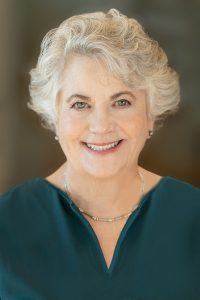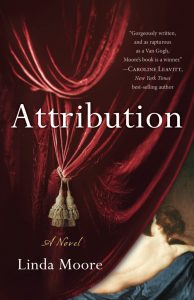Inspiration for Attribution by Linda Moore
 Where do ideas come from? Original ideas, rare and precious, don’t happen often. Indeed, most ideas evolve from a collage of experiences, our own and those we hear or read about. Fiction writing or, if you prefer, storytelling offers a unique opportunity to mold a world of existing ideas into something new.
Where do ideas come from? Original ideas, rare and precious, don’t happen often. Indeed, most ideas evolve from a collage of experiences, our own and those we hear or read about. Fiction writing or, if you prefer, storytelling offers a unique opportunity to mold a world of existing ideas into something new.
Attribution began over a decade ago when I sat in a darkened auditorium listening to an art scholar speaking about attributing a painting that was labeled ‘School of Seville.’ Riveted, I learned about the challenges confronting him to leap over hundreds of years and prove a painting’s origins. This fascinating topic and the process led me to read and study more.
The genesis of Attribution’s narrative began in that auditorium, but the final book took form many years later and grew well beyond that original story. I examined resources on attribution, interviewed conservators, and read about the art of the Spanish Golden Age. I wrote and rewrote to make the characters believable, the plot structure complex and captivating, and the writing enjoyable to read.
Details of actual history provide inspiration for fictional ideas. I read a biography of the Count-Duke of Olivares and learned he had no legitimate sons and so Olivares legitimized his bastard. Unfortunately, that son died a few years after his father and thus did not work with my story’s need for lineage back to that time. Anyone might have jumped to the conclusion I did that if there was one illegitimate son, a writer could imagine another, unknown to history. Thus, Antonio and his lineage advanced into the story.
Another example of the interaction between actual history and fictional narrative is Flaminia Triva, Velázquez’s mistress. I had created a fictional mistress, a painter, whom the artist had met in Italy while he traveled there. Like magic, I was reading an obscure history from 1724 that mentioned when Velázquez was in Rome, he painted a number of people including Flaminia Triunfi, a portrait now lost. More research corrected her name to Flaminia Triva, sister of painter Antonio Triva. In this example, I imagined something that turned out to be true.
Personal experiences form another source of ideas. It has been said all novels are autobiographical. I would suggest that experiences and memories emerge as seeds for creative ideas without the author’s awareness. Sometimes the writer doesn’t see a connection until much later. For example, a writer friend encouraged me to expand the story of Cate’s younger brother who died by drowning to deepen her character and discover who she was. I took his advice and wrote more and developed scenes of friction with her parents. The relationship becomes strained as Cate attempts to resolve the conflict between who she is and the grief her parents feel from losing her brother.
I wrote in my author’s note that it may test the reader’s credulity, but I did not make the connection to my own sister who died at age 20 when I was 25. Grieving parents was something I understood well in my own experience and apparently needed to write about it. Many people have told me they cried when they read that scene near the end with her parents on the telephone.
My experience with academia (for a while I collected degrees) provided another opportunity to write about relationships and what women face in a male-dominated world. Several professors read Attribution and said sexism used to dominate academic departments, but policies and more opened-minded views predominate now. I took a survey of younger friends, more recent graduates to test that allegation. All of them, without exception declared, “Oh yes, Professor Jones, I knew that guy.” Professor Jones is a composite of several professors I encountered. The welcome cocktail party scene came from a real event where the department chair exclaimed as I introduced him to my husband, “We didn’t know you were married.” I felt as dejected as Cate and as though my department chairman had written me off before he even knew me. He inspired Professor Jones’s twirling finger and nervous use of the pencil.
Finally, ideas do come from the ether: a dream, a lightning bolt, a random thought while you sit at the keyboard or sleep on the beach. These are the true imaginative ideas that the writer cannot associate with anything of their own. But who knows if a forgotten connection exists somewhere. When I studied novel writing, we were taught all writers should eavesdrop, in a benign way of course. In cafes, waiting in the doctor’s office, in the grocery line, at the airport, not only for that single sentence that can be the source of an amazing story, but also for that illusive voice, critical to making a character unique.
Personally, I am not my best when responding to prompts so popular in writing lectures. I need time to think, to know where I am going before I punch words into my computer. In other words, ideas come first, and the words follow. Some writers find their creativity flows from a stream of consciousness instead of the more deliberate approach and others write from both or a wellspring of creativity.
—
Linda Moore is an author, traveler and recovering gallery owner. She has served on numerous museum boards and designed art education programs. Her first novel, Attribution, debuts on 10/11/22, and is based on her love of art history.
ATTRIBUTION
 Art historian Cate Adamson, still grieving the death of her brother and desperate to succeed, leaves her troubled parents in the Midwest to complete her doctorate in New York only to find herself assigned to a misogynist advisor. She attempts to impress him until she discovers a hidden painting, possibly a Baroque masterpiece, in the university basement. Risking her career, financial disaster, and further alienation from her family, she flees to Spain with the painting to consult art experts.
Art historian Cate Adamson, still grieving the death of her brother and desperate to succeed, leaves her troubled parents in the Midwest to complete her doctorate in New York only to find herself assigned to a misogynist advisor. She attempts to impress him until she discovers a hidden painting, possibly a Baroque masterpiece, in the university basement. Risking her career, financial disaster, and further alienation from her family, she flees to Spain with the painting to consult art experts.
Antonio, an impoverished duke, clings to the decaying legacy of the House of Olivares. When he meets Cate on the train to Seville, he joins her search, and they uncover evidence in his five hundred-year old library to support the painting’s provenance including a document about the artist’s final years that will shock the titans of art history. But Cate vacillates about revealing the truth, fearful that it may destroy her career, her family’s expectations, and her future with Antonio.
Written with vivid prose, rich references to seventeenth century Spanish art, compelling characters and a historical puzzle, Attribution is the story of one contemporary woman’s journey to understand the past and unlock her future.
BUY HERE
Category: On Writing























